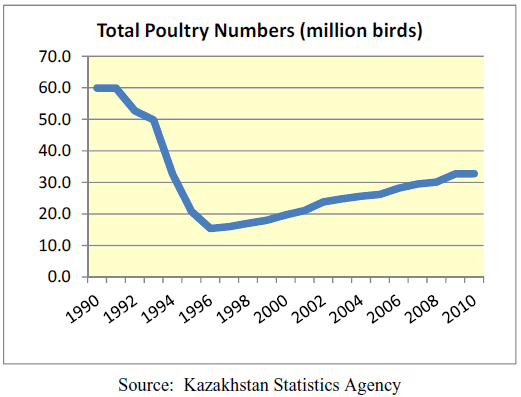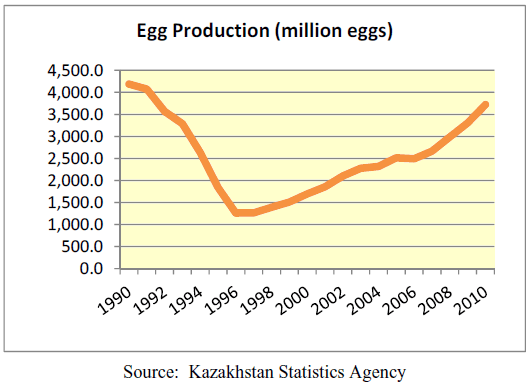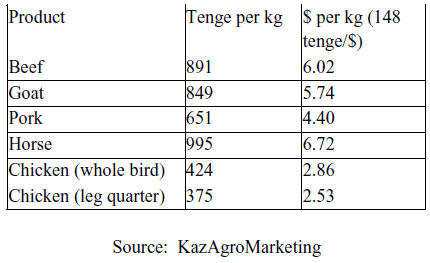



Kazakhstan’s Poultry Sector is Expanding
Kazakhstan’s poultry sector is steadily expanding, although production is still only half of the level before the break-up of the Soviet Union, according to the USDA Foreign Agricultural Service.Kazakhstan’s poultry sector is steadily expanding, although it remains far smaller than during the Soviet Union. The priority sector in agriculture for the Government of Kazakhstan is the cattle sector, and as a result the largest share of subsidies and government support is focused on increasing cattle herds and beef production. Nevertheless, the Government also continues to provide subsidies and beneficial credit terms to the poultry sector to encourage growth. Egg production has recovered faster than broiler production in Kazakhstan, and has nearly reached the levels of before the breakup of the Soviet Union. As a result egg production has almost reached consumption, and Kazakhstan is becoming self-sufficient in egg production. For broiler meat, however, the recovery is much slower and necessitates continued large amount of imports.
Despite strong domestic demand for poultry, the Government of Kazakhstan, in conjunction with other members of the Customs Union (Belarus and Russia), in 2010 implemented a tariff-rate quotas for poultry meat. This has reduced imports and has led to rising poultry prices.
General Information
Production
Kazakhstan’s poultry production declined rapidly following the break-up of the Soviet Union and the removal of large-scale government subsidies and collapse of government-owned farms (SOVKHOZs). According to the Kazakhstan Statistics Agency, in 1990, the poultry population in Kazakhstan was nearly 60 million birds, and this number collapsed all the way to below 20 million by 2000. Since that time, there has been a gradual recovery and by October 2011, there were 36 million birds.
There are currently 39 poultry farms for egg production and 23 poultry farms for meat production in Kazakhstan. Within the 23 meat poultry farms are 14 farms which also are breeding operations. Broiler meat production in Kazakhstan has expanded with bird numbers, and has risen from 65,000 tons in 2006, to 120,000 tons expected in 2012. The goal of the government of Kazakhstan is to produce 140,000 tons by 2014.
Domestic production now accounts for about half of all poultry consumed in Kazakhstan. However, much of this domestic production is consumed directly by households and does not enter marketing channels. Therefore, poultry found in urban markets remains primarily imported. Domestically produced broiler meat is typically sold as whole broilers, while imported products are almost entirely leg quarters. In addition, domestic products are typically priced significantly higher than imported poultry (see section on Prices).


The Kazakh Ministry of Agriculture has published a SWOT analysis for poultry production in Kazakhstan which clearly identified the major problems and opportunities in the sector. These include:
- Strengths
- Growing industrial capacity
- Strong demand on the domestic market
- Weaknesses
- Outdated technologies
- Low production efficiency
- Lack of professional staff
- High costs for domestically produced products and low price competitiveness
- Current assets are not enough
- High dependence on imported feed additives (premix), vaccines and breeding material
- The current variety of locally produced crops is not enough for feed production
- Opportunities
- Ability to use current industrial production capacities at full capacity
- Reconstruction and building of new broiler poultry farms
- Import substitution and increased market share on the domestic market
- Increase the production efficiency and decrease costs
- Improve domestic products competitiveness
- Threats
- Hard to attract investments due to financial crisis
- Strong competition with Russian and Ukrainian producers
- Low prices from poultry meat imports
In order to support poultry and egg production, the Government of Kazakhstan is providing a number of different subsidies and other financial support to the sector including:
- Up to a 45 per cent subsidy for poultry feed production. In addition, grains from government stocks are frequently sold at below market rates.
- 60-65 tenge (KZT; US$.40-$.45) subsidy per kilo of poultry meat
- KZT2.0-2.5 subsidy for each table egg (approximately $0.16-$0.21 per dozen)
- Up to a 50 per cent subsidy for parent stock day-old chicks for egg production, although no more than KZT45 ($0.30) per chick
- Up to a 50 per cent subsidy for grandparent stock day-old chicks for meat production, but no more than KZT275 ($2) per chick
- Subsidised and beneficial credit terms including for leasing of equipment. This includes subsidized interest rates of up to 80 per cent of the interest amount, as well as longer terms than private loans.
Consumption
Beef continues to be the primary meat consumed in Kazakhstan, accounting for an estimated 39 per cent of meat consumption, followed by poultry with 21 per cent, pork with 20 per cent, goat/sheep with 14 per cent and horse with seven per cent. Poultry consumption fell in 2008 and 2009 as a result of economic downturn, and although it has recovered import restrictions continue to limit the amount of poultry meat available to meet domestic demand. Poultry is by far the cheapest animal meat, with prices typically half of those of other meats.
Trade
Kazakhstan currently imports approximately half of all the poultry consumed, with the lion's share (nearly 90 per cent) of this coming from the United States. Imports have fallen somewhat in recent years, however, as a result of import barriers. Within the framework of the Customs Union between Kazakhstan, Russia and Belarus, these countries all established tariff-rate quotas for beef, pork and poultry starting in 2010. The quota amount for poultry for Kazakhstan was set at 110,000 tons (imports had been as high as 150,000 tons in the years before this quota was announced). Any poultry imported in this quota is assessed a duty rate of 25 per cent of the customs value, but not less than €0.20 per kilogram, while any poultry imported in excess of this quota is assessed a duty rate of 80 per cent of the customs value, but not less than €0.70 per kilogram. The quota amount for 2011 remained the same as in 2010, at 110,000, and the quotas for 2012 have not yet been announced.
US poultry meat is almost entirely in the form of chicken leg quarters, which are shipped to Kazakhstan through the Baltic ports of Klaipeda in Lithuania and Riga in Latvia. (In some trade figures, these exports are shown as being destined for Latvia and Lithuania although they are in fact being transshipped to Kazakhstan.) These products then move by rail through Belarus, Ukraine and Russia in refrigerated wagons. In 2010, the Kazakhstan Customs Service reported imports from the United States at 105,000 tons, with a value of $83 million. As Almaty is the largest city and the largest logistics centre with the highest concentration of cold stores, the majority of imports come to Almaty and then are distributed throughout the rest of Kazakhstan.
Before the introduction of tariff rate quotas, Kazakhstan (and Almaty in particular) was a regional distribution centre for Central Asia, and shipped to Uzbekistan, Kyrgyzstan and Tajikistan, although this has now ceased. For this year, local traders have indicated that the quota amount is too small to satisfy demand, and many of them have used up their quotas already. Because of this, they will now have to start paying the higher out-of-quota rates, and they indicated that this is causing a rise in domestic poultry prices.

Prices
Prices for poultry remain far below those for other meat products (See table below). As of 1 November 2011, the average wholesale price in Kazakhstan for chicken (whole birds) was KZT424 ($2.86) per kilogram, and for chicken leg quarters was KZT375 ($2.53) per kilogram. Nearly all of the chicken leg quarters are imported and nearly all of the whole broilers are domestically produced.

Further Reading
| - | You can view the full report by clicking here. |
December 2011








